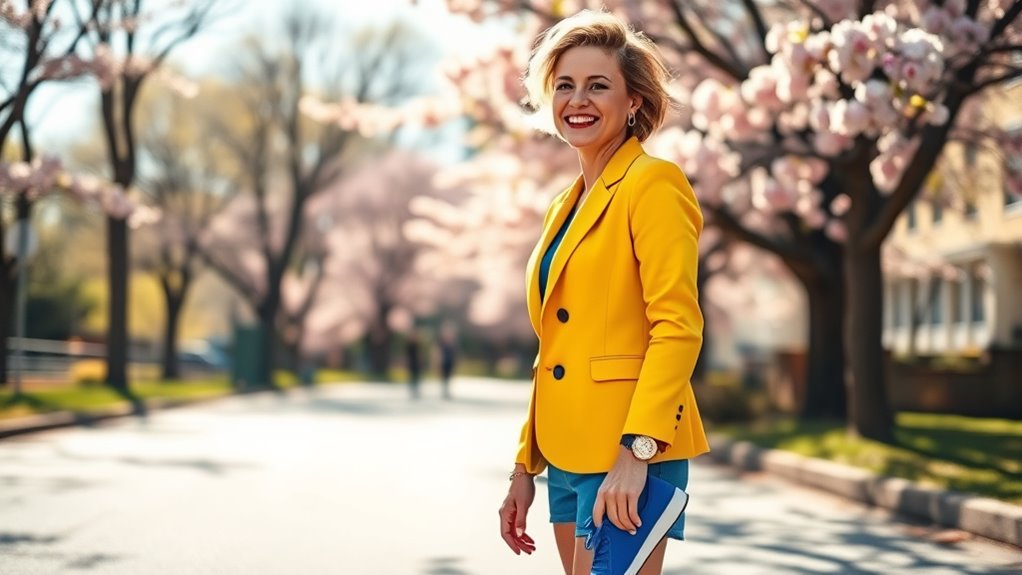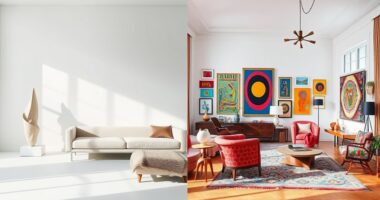Dopamine dressing works by choosing clothing that evokes happiness, confidence, and excitement, which directly stimulates your brain’s release of dopamine, boosting your mood. Bright colors and expressive styles trigger positive emotions and send powerful psychological signals. When you wear outfits that reflect how you want to feel, you activate neural pathways linked to joy and motivation. Keep exploring how small style changes can make a big difference in your emotional well-being.
Key Takeaways
- Psychologists highlight that wearing bright, bold colors can stimulate dopamine release, elevating mood and promoting feelings of happiness.
- Dopamine dressing leverages clothing choices to activate neural pathways associated with pleasure and motivation.
- Fashion psychology research shows that expressing oneself through clothing boosts confidence and emotional well-being.
- Small wardrobe changes, like adding statement accessories, can trigger significant positive emotional shifts.
- Personalization of outfits supports resilience against negative emotions by enhancing self-esteem and authenticity.
Understanding Dopamine and Its Role in Happiness

Dopamine is a neurotransmitter that plays a key role in how we experience pleasure and reward. Its effects on neurotransmitter activity influence your feelings of happiness and motivation. When dopamine levels rise, you often feel more alert, focused, and energized, which boosts your emotional regulation. This chemical helps you associate certain activities or stimuli with positive feelings, reinforcing behaviors that bring you joy. Understanding dopamine’s effects on your brain can help you recognize how your mood shifts and why some experiences make you feel better. By managing dopamine levels, you can better regulate your emotions, leading to improved overall well-being. Additionally, engaging in activities that promote high dopamine release can enhance your mood and motivation. Recognizing these effects empowers you to make choices that support balanced dopamine activity and foster happiness.
The Science Behind Color and Mood Enhancement

Colors have a powerful impact on your emotions because they can influence your mood almost instantly. This is the core of color psychology, which explores how specific hues evoke certain feelings and states of mind. For example, bright yellows can boost your energy and optimism, while calming blues promote relaxation and focus. When you understand how color impacts mood regulation, you can intentionally choose clothing that enhances your emotional well-being. The science shows that color cues trigger psychological responses, shaping your mood without you even realizing it. Additionally, automation technologies are increasingly used to personalize experiences, including in areas like fashion and mood regulation. By selecting colors that align with your desired emotional state, you can harness the mood-boosting effects of color psychology, making your wardrobe a simple yet effective tool for emotional regulation.
How Clothing Choices Influence Brain Chemistry

Your clothing choices can directly influence your brain chemistry by signaling your emotional state and shaping your mood. Through the lens of fashion psychology, what you wear impacts how you feel internally. A wardrobe transformation, such as choosing brighter colors or confident styles, can activate positive neural pathways, boosting dopamine and serotonin levels. When you dress intentionally, you send signals to your brain that reinforce feelings of confidence, happiness, and control. Even small shifts—like adding a favorite accessory or wearing a power suit—can trigger chemical responses that elevate your mood. Recognizing how clothing influences brain chemistry empowers you to make wardrobe choices that support emotional well-being and foster a more optimistic outlook. Your attire becomes a tool for mood regulation, not just appearance. Additionally, understanding the impact of clothing on brain chemistry can help you develop a more mindful wardrobe aligned with your emotional goals.
Psychological Benefits of Expressive Fashion

Expressive fashion allows you to communicate your personality and values without saying a word, offering powerful psychological benefits. Through fashion psychology, you can use clothing to convey your emotions and identity, boosting your confidence and sense of authenticity. When you choose outfits that reflect how you feel or who you are, it encourages emotional expression, which can improve your mood and reduce stress. Wearing expressive clothing helps you feel more in control of your image and creates a positive feedback loop—enhancing self-esteem and resilience. This form of emotional expression not only fosters a deeper connection with yourself but also signals openness to others. Additionally, engaging in emotional expression through clothing can support your overall mental well-being by aligning your outer appearance with your inner state. Overall, expressive fashion empowers you to align your outer appearance with your inner state, promoting mental well-being.
Practical Tips for Incorporating Dopamine Dressing

To start boosting your mood with dopamine dressing, focus on color coordination to create eye-catching outfits. Incorporate bold accessories that reflect your personality and lift your spirits. Also, choose comfortable fabrics so you can feel good while looking great throughout the day. Adding elements inspired by Victorian aesthetics, such as intricate patterns and vintage-inspired details, can enhance the nostalgic and uplifting feel of your outfit.
Color Coordination Strategies
Color coordination is a powerful way to boost your mood through dopamine dressing, and mastering some practical strategies can make it easier to incorporate vibrant hues into your wardrobe. First, understand fashion psychology—certain color combinations can evoke specific emotions and energy levels. To stay organized, categorize your wardrobe by color and outfit purpose, making it easier to put together cheerful, coordinated looks quickly. Stick to a color palette that resonates with your mood or goals, such as bright yellows or energetic reds. Use color blocking techniques to create eye-catching ensembles without overthinking. Regular wardrobe organization guarantees you can effortlessly find and pair your favorite hues, making dopamine dressing a seamless part of your daily routine. Additionally, incorporating dog-inspired colors or accessories can add a playful touch that enhances your mood.
Accessorize With Bold Pieces
Adding bold accessories is an effective way to elevate your dopamine dressing routine and instantly boost your mood. By incorporating eye-catching pieces, you enhance your outfit’s visual impact and express your personality. Focus on accessory styling with statement earrings, chunky necklaces, or vibrant scarves. Don’t shy away from bold patterns—think animal prints, geometric designs, or floral motifs—that can add energy and excitement to your look. Use the table below for quick inspiration:
| Accessory Type | Bold Pattern Ideas | Styling Tips |
|---|---|---|
| Earrings | Animal print, polka dots | Pair with neutral outfits |
| Scarves | Stripes, florals | Tie in different ways |
| Hats | Bright colors, patterns | Keep other accessories simple |
| Bags | Geometric, abstract | Match with one bold element |
Experiment to find what makes you feel vibrant and confident. Incorporating pattern mixing techniques can further amplify your style and mood.
Prioritize Comfortable Fabrics
Prioritizing comfortable fabrics is essential for making dopamine dressing both enjoyable and sustainable. When you choose fabrics with superior softness, you boost your sensory comfort and create a comforting wardrobe. Here are four tips to help you select the best materials:
- Opt for natural fibers like cotton, silk, or linen that feel gentle against your skin.
- Look for fabrics with a soft finish, enhancing fabric softness and sensory pleasure.
- Avoid rough or stiff materials that can cause irritation or discomfort.
- Consider layering with plush textures like cashmere or fleece for added sensory comfort.
- Selecting high-quality fabrics can significantly improve the overall feeling and durability of your wardrobe choices.
Real-Life Examples and Success Stories

Many people have experienced a noticeable boost in their mood simply by incorporating dopamine-boosting outfits into their daily routines. Case studies reveal powerful personal transformations driven by wardrobe choices. For example, one individual reported feeling more confident and energized after wearing bold, colorful clothing for a week. Another shared how donning a favorite outfit on tough days lifted their spirits and improved their outlook. These real-life examples demonstrate how small style changes can create significant emotional shifts. By intentionally choosing clothing that sparks joy, you can harness dopamine’s mood-enhancing effects. Additionally, awareness of small mistakes and how to address them can contribute to a more resilient mindset. These success stories prove that dopamine dressing isn’t just theory; it’s a practical, accessible way to boost your well-being and cultivate a more positive mindset.
Frequently Asked Questions
Can Dopamine Dressing Be Effective for All Age Groups?
Dopamine dressing can offer benefits across all age groups, but its effectiveness varies based on age-specific benefits and generational preferences. Younger people might enjoy bold, vibrant colors that boost energy, while older individuals may prefer more subdued tones that provide comfort. Tailoring your wardrobe to your preferences helps maximize mood benefits, making dopamine dressing adaptable and effective regardless of age, as long as it aligns with your personal style and comfort.
Are There Specific Colors That Universally Boost Mood?
You might wonder if certain colors universally boost mood. According to color psychology, bright colors like yellow and orange often trigger positive emotional responses, making you feel happier and energized. However, individual reactions vary based on personal experiences and cultural factors. While some colors tend to uplift most people, it is crucial to choose hues that resonate with your personal preferences to maximize their mood-boosting effects.
How Long Does the Mood Boost From Dopamine Dressing Last?
Ever wonder how long that uplifting feeling from dopamine dressing sticks around? In fashion psychology, the emotional impact can last from a few hours to a full day, depending on your mindset and environment. Wearing colors or styles that make you feel good can give a quick mood boost, but for lasting positivity, it’s best to combine your wardrobe choices with self-care and positive routines.
Can Dopamine Dressing Help With Mental Health Conditions?
Dopamine dressing can support your mental health by harnessing color psychology and fashion therapy. Wearing bright, uplifting colors may improve your mood and boost confidence, providing a simple, accessible form of self-care. While it’s not a substitute for professional treatment, incorporating cheerful outfits into your routine can complement your mental health strategies and help manage stress or anxiety, making you feel more empowered and in control.
Is There Scientific Evidence Linking Fashion Choices to Long-Term Happiness?
Imagine your wardrobe as a garden where each color and style blooms with potential. While fashion psychology and color psychology suggest your choices can influence mood, there’s limited scientific proof linking them to long-term happiness. You can cultivate daily joy by dressing intentionally, but lasting happiness depends on broader factors. Think of fashion as a vibrant, uplifting corner of your mental landscape, not the entire garden.
Conclusion
By embracing dopamine dressing, you can boost your mood and express yourself authentically—think of it as your personal Renaissance, where colors and styles become your palette for happiness. When you choose vibrant outfits, you’re not just making a fashion statement; you’re rewiring your brain for positivity. So, go ahead—dress boldly and let your wardrobe be your secret weapon against gloom, much like the spirited courtiers of yesteryear who knew the power of a well-chosen ensemble.









